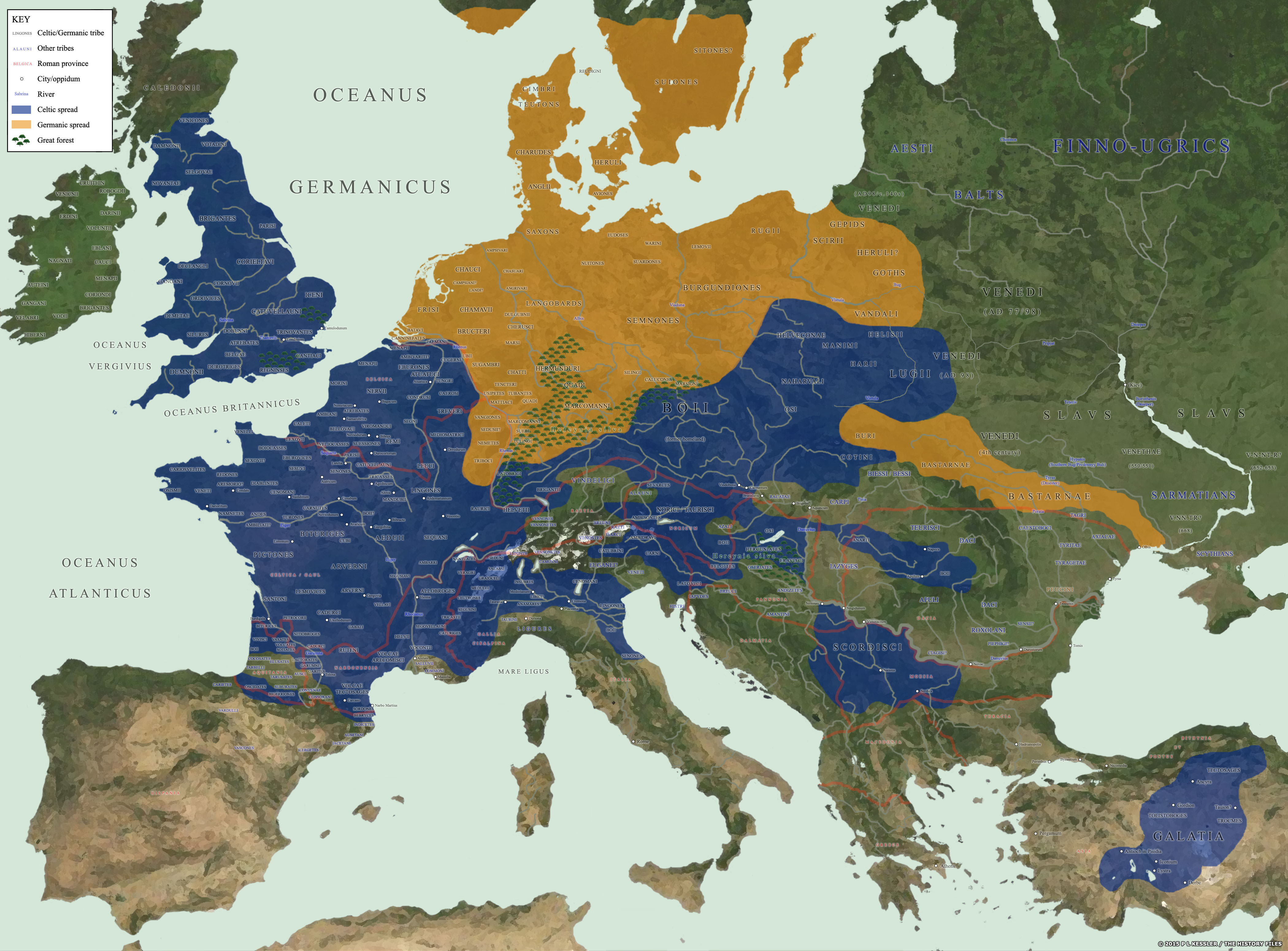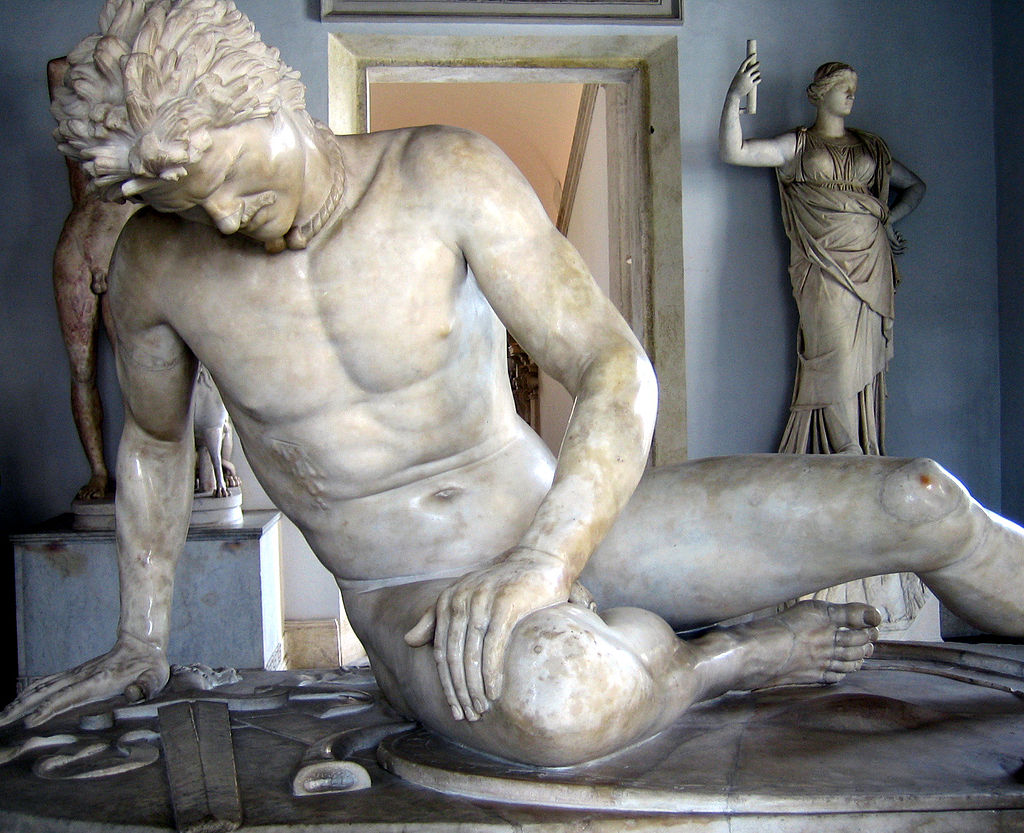|
|
Galatia (B)
Galatia (B)

Expansion of the Celtic culture in the third century BC according to Francisco Villar. |
|
|
| |
|
Galatia, ancient district in central Anatolia that was occupied early in the 3rd century BC by Celtic tribes, whose bands of marauders created havoc among neighbouring Hellenistic states. Invited from Europe to participate in a Bithynian civil war (278 BC), the Gallic horde plagued western Anatolia until checked by the Seleucid king Antiochus I at the so-called Elephant Battle (275 BC). At that point the Celts, called Galatae (Galatians) by 3rd-century writers, settled in the territory to which they gave their name. The Galatians, having joined the Seleucids against Rome (winter 190-189 BC), brought upon themselves a Roman punitive expedition (189 BC) from which they never recovered. Passing successively under the rule of Pergamum and Pontus, Galatia became a Roman protectorate (85 BC) ruled by puppet kings. Though originally possessing a strong cultural identity, the Galatians by the 2nd century AD had become absorbed into the Hellenistic civilization of Anatolia. |

|
|
|
Galatia (W)
Galatia (W)
Celtic Galatia
|
|
Tectosages
Tectosages (W)
The Tectosages or Tectosagii (Taker-Seekers) were one of the three ancient Gaulish tribes of Galatia in central Asia Minor, together with the Tolistobogii and Trocmii.
According to Strabo, the Tectosages came originally from the region around Tolosa in Gaul, where they had been part of the tribal confederation of the Volcae. During the Gallic invasion of the Balkans, c. 280 BC, a branch of the Volcae Tectosages, returning from Delphi, split from the main group and joined two other tribes, the Tolistobogii and the Trocmi. Around 278 BC they were hired as mercenaries by Nicomedes I of Bithynia and crossed the Bosporus. After leaving Bithynia they raided in Asia Minor and finally settled in eastern Phrygia, where they established a new Celtic confederate identity as the Galatians. The Tectosages occupied the centre of the Galatian territory, round their capital Ancyra, with the Tolistobogii in the west and the Trocmii to the east. |
|
|
|
|
The terms "Galatians" came to be used by the Greeks for the three Celtic peoples of Anatolia: the Tectosages, the Trocmii, and the Tolistobogii. By the 1st century BC the Celts had become so Hellenized that some Greek writers called them Hellenogalatai (Ἑλληνογαλάται). The Romans called them Gallograeci. Though the Celts had, to a large extent, integrated into Hellenistic Asia Minor, they preserved their linguistic and ethnic identity.
By the 4th century BC the Celts had penetrated into the Balkans, coming into contact with the Thracians and Greeks. In 380 BC they fought in the southern regions of Dalmatia (present day Croatia), and rumors circulated around the ancient world that Alexander the Great's father, Philip II of Macedonia had been assassinated by a dagger of Celtic origins. Arrian writes that "Celts established on the Ionic coast" were among those who came to meet Alexander the Great during a campaign against the Getae in 335 BC.
Several ancient accounts mention that the Celts formed an alliance with Dionysius I of Syracuse who sent them to fight alongside the Macedonians against the Thebans. In 279 BC two Celtic factions united under the leadership of Brennus and began to push southwards from southern Bulgaria towards the Greek states. According to Livy, a sizable force split off from this main group and head toward Asia Minor.
For several years a federation of Hellespontine cities, including Byzantion and Chalkedon prevented the Celts from entering Asia Minor but this changed when Nikomedes I of Bithynia allied with some of the Celtic leaders in a war against his brother Zipoetes and the Seleucid king Antiochus I. When the Celts finally entered Asia Minor chaos ensued until the Celts were briefly routed by Antiochus' army in the Battle of Elephants. In the aftermath of the battle the Celts withdrew to Phrygia, eventually settling in Galatia. The territory of Celtic Galatia included the cities of Ancyra (present day Ankara), Pessinus, Tavium, and Gordion. |
, 6th–3rd century BC-- 1280px-Celtic_Expansion.png)
Map showing the various campagins of Celtic tribes between the 6th and 3rd centuries BCE. |
|
|

Map showing the various Celtic and Germanic tribes around circa 52 BCE. |
|
|

|
|
|
Galatians (people) (W)
Galatians (people) (W)
The Galatians (Γαλάται, romanized: Galátai; Latin: Galatae, Galati, Gallograeci; Greek: Γαλάτες, romanized: Galátes, lit. 'Gauls') were a Gallic (Celtic) people of the Hellenistic period that dwelt mainly in the north central regions of Asia Minor or Anatolia, in what was known as Galatia, in today's Turkey. In their origin they were a part of the great migration which invaded Macedon, led by Brennus. The originals who settled in Galatia came through Thrace under the leadership of Leotarios and Leonnorios c. 278 BC. They consisted mainly of three tribes, the Tectosages, the Trocmii, and the Tolistobogii, but there were also other minor tribes. They spoke a Celtic language, the Galatian language, which is sparsely attested.
In the 1st century AD, many Galatians of the Roman Empire were Christianized by Paul the Apostle's missionary activities. The Epistle to the Galatians by Paul the Apostle is addressed to Galatian Christian communities and is preserved in the Bible (i.e. the New Testament). |
History
Seeing something of a Hellenized savage in the Galatians, Francis Bacon and other Renaissance writers called them Gallo-Graeci ('Gauls settled among the Greeks') and the country Gallo-Graecia, as had the 3rd century AD Latin historian Justin. The more usual term was Ancient Greek: Ἑλληνογαλάται, romanized: Hellēnogalátai of Diodorus Siculus' Bibliotheca historica v.32.5, in a passage that is translated "...and were called Gallo-Graeci because of their connection with the Greeks", identifying Galatia in the Greek East as opposed to Gaul in the West.
Brennus invaded Greece in 281 BC with a huge war band and was turned back before he could plunder the temple of Apollo at Delphi. At the same time, another Gaulish group of men, women, and children were migrating through Thrace. They had split off from Brennus' people in 279 BC, and had migrated into Thrace under their leaders Leonnorius and Lutarius. These invaders appeared in Asia Minor in 278-277 BC; others invaded Macedonia, killed the Ptolemaic ruler Ptolemy Ceraunus but were eventually ousted by Antigonus Gonatas, the grandson of the defeated Diadoch Antigonus the One-Eyed.
The invaders came at the invitation of Nicomedes I of Bithynia, who required help in a dynastic struggle against his brother. Three tribes crossed over from Thrace to Asia Minor. They numbered about 10,000 fighting men and about the same number of women and children, divided into three tribes, Trocmi, Tolistobogii and Tectosages. They were eventually defeated by the Seleucid king Antiochus I, in a battle where the Seleucid war elephants shocked the Celts. While the momentum of the invasion was broken, the Galatians were by no means exterminated.
Instead, the migration led to the establishment of a long-lived Galatian territory in central Anatolia, which included the eastern part of ancient Phrygia, that became known as Galatia. There they ultimately settled; once strengthened by fresh accessions of the same clan from Europe, they overran Bithynia and supported themselves by plundering neighbouring countries.
The Galatians invaded the eastern part of Phrygia on at least one occasion.
The constitution of the Galatian state is described by Strabo: conformably to custom, each tribe was divided into cantons, each governed by a tetrarch with a judge under him, whose powers were unlimited except in cases of murder, which were tried before a council of 300 drawn from the twelve cantons and meeting at a holy place, twenty miles south-west of Ancyra, written in Ancient Greek: Δρυνεμετον, romanized: Drunemeton/Drynemeton, lit. 'holy place of oak'. It is likely it was a sacred oak grove, since the name means 'sanctuary of the oaks' in Gaulish: *dru-nemeton (from drus, lit. 'oak', and nemeton, lit. 'sacred ground'). The local population of Cappadocians were left in control of the towns and most of the land, paying tithes to their new overlords, who formed a military aristocracy and kept aloof in fortified farmsteads, surrounded by their bands.
These Galatians were warriors, respected by Greeks and Romans (illustration, below). They were often hired as mercenary soldiers, sometimes fighting on both sides in the great battles of the times. For years the chieftains and their war bands ravaged the western half of Asia Minor as allies of one or other of the warring princes without any serious check — until they sided with the renegade Seleucid prince Antiochus Hierax, who reigned in Asia Minor. Hierax tried to defeat Attalus, the ruler of Pergamon (241-197 BC), but instead the Hellenized cities united under Attalus' banner and his armies inflicted several severe defeats upon Hierax and the Galatians in c. 232, forcing them to settle permanently and to confine themselves to the region to which they had already given their name. The theme of the Dying Gaul (a famous statue displayed in Pergamon) remained a favourite in Hellenistic art for a generation.

“The Dying Gaul,” a Roman marble copy of a Hellenistic work of the late third century BC, Capitoline Museums, Rome. |
|
Their right to the district was formally recognized.
The king of Attalid Pergamon employed their services in the increasingly devastating wars of Asia Minor; another band deserted from their Egyptian overlord Ptolemy IV after a solar eclipse had broken their spirits.
In 189 BC, Rome sent Gnaeus Manlius Vulso on an expedition against the Galatians, the Galatian War, defeating them. Galatia was henceforth dominated by Rome through regional rulers from 189 BC onward. Galatia declined, at times falling under Pontic ascendancy. They were finally freed by the Mithridatic Wars, during which they supported Rome.
In the settlement of 64 BC, Galatia became a client-state of the Roman empire, the old constitution disappeared, and three chiefs (wrongly styled 'tetrarchs') were appointed, one for each tribe. But this arrangement soon gave way before the ambition of one of these tetrarchs, Deiotarus, the contemporary of Cicero and Julius Caesar, who made himself master of the other two tetrarchies and was finally recognized by the Romans as 'king' of Galatia. |
Kings of Galatia, 62-25 BC (W)
From then until 62 BC, the Galatians ruled themselves by means of decentralized Tetrarchies, but in 62, the Romans established a Kingdom of Galatia, which lasted around 35 years.
| Name |
Lifespan |
Reign start |
Reign end |
Notes |
Family |
Image |
| Deiotarus |
|
62 BC |
40 BC |
Co-ruler with Brogitarius |
|
|
| Brogitarius |
|
63 BC |
50 BC |
Co-ruler with Deiotarus |
|
|
| Castor |
|
40 BC |
36 BC |
|
|
|
| Amyntas |
died 25 BC |
37 BC |
25 BC |
|
|
 |
|

|
|
|
|
|
|

